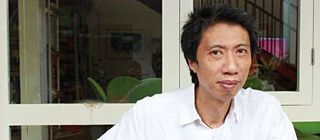Dance
Interview mit Iswanto Hartono

Iswanto Hartono speaks about his involvement in the dance production Volution / Groove Space, which was put together by German choreographer Sebastian Matthias.
Iswanto Hartono speaks about his involvement in the dance production Volution / Groove Space, which was put together by German choreographer Sebastian Matthias.
As a designer with a background in architecture, what was your first impression when you were invited to meet and collaborate with a choreographer?
Actually, the first time I came into contact with the world of fine art was when I was working together with a community of performance artists. After studying architecture at the Tarumanagara University in Jakarta (UNTAR), I studied fine art at the Jakarta Art Institute (IKJ). However, I never finished a degree there, since I only stayed for two years. After that I got a scholarship to study urban politics in India. While I was at IKJ I happened to work together with Suptrapto Suryodarmo and Agoes Jolly, who are both, in my opinion, the pioneers of performance art in Indonesia. It was through them that I later met with fine artists in the broader sense, such as Halim and Budi Otong. So when Sebastian Matthias invited me to meet and we were finally able to talk about a work to be made in Jakarta, I was immediately interested because of my relevant prior experience, even if it had been a while since I took on a project of that nature.
Until now, based on your discussion with Sebastian Matthias, you previously worked from the concept “artificial park“ for an installation work that you made. Listening to your stories, I remember that you previously made several works with the same theme. Why are you interested specifically in “parks“, especially artificial parks with plants made of plastic?
It’s true, I have explored this theme before and I am still interested in exploring it further. Why the concept of the park? Maybe there is some connection with my background in architecture. As an architect, I am accustomed to grappling with forms that already exist, “ordinary” objects, in the sense that they are not works made by artists. Usually, these objects are something mass-produced, and can be easily obtained. I myself am not a true artist, I don’t have any special training in the broader sense, or a strong background like an artist who works on the basis of beauty, and whose work is their own expression. Aside from that, I have a special love of toys, which tend to have elements such as being able to take them apart, put them back together again, pair them up, change them into something else, and that kind of thing.
Do you also see certain conditions in Indonesia that have strengthened your interest in the ordinary objects that you mentioned earlier?
Certainly, there are. To give some social context, I see this among the masses today: we have a tendency to produce on a mass scale everything that is artificial in the modern world. I am familiar with what I usually see and encounter in the area of Mangga Dua. These artificial objects look so close to the original, while some others do not.
In the dance production volution / groove space, aside from Sebastian Matthias and the German dancers, you also worked together with other Indonesian artists such as Irwan Ahmett, Cut and Rescue, and fashion designer Didiet Maulana. How do you see this diverse constellation and its ability to collaborate? Is there, for example, a restlessness that what you will make won’t be easily received by other people?
Actually, I would also like to know why right until the last minute Sebastian decided chose to work together with us all in this production! (Laughs). To be honest, I already frequently interact with all of these artists, except for Didiet Maulana. But I feel that I don’t have worries or fears to do with our cooperation. In fact, it is more fun to work with others with whom we are already accustomed to their work habits or their artistic approach. I am very interested in seeing the results from all of our discussions, our meetings in the production period, and of course the final performance.